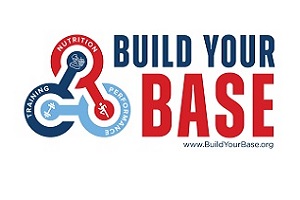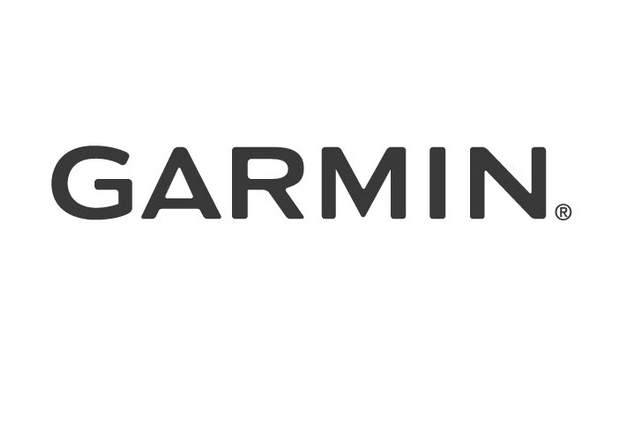Kultan Keihas: Looking back ... and looking ahead
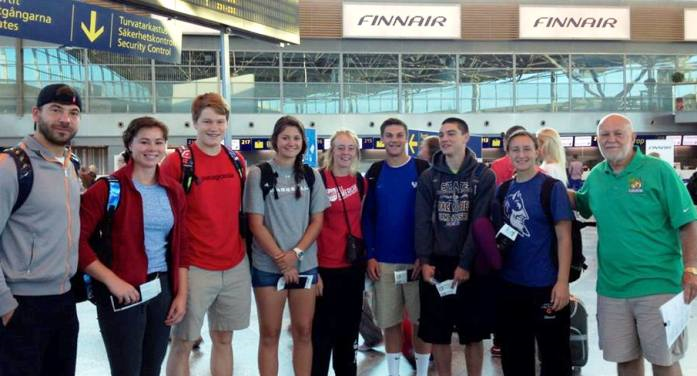
The 2012-2013 Kultan Keihas crew departing Finland last month after a great week of training and competition.
These mid-summer days, leading up to all the excitement of a final year of high school, just got a whole lot more interesting for Karen Bulger, a rising Northwest Christian (Lacey, Wash.) senior thrower, who specializes in the javelin.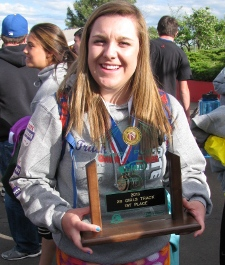
Bulger won her Class 2B state title in that event this year (pictured at right with her state team points award, photo by Jeff Bulger), threw a US#3 161-5 in the Pasco Invite, and was second in the World Youth Trials this June. It was tough not getting chosen for Team USA, but she was certainly ecstatic when she learned that she’s not only going to be able to participate in two of the outstanding clinics in the country this fall and coming winter, but be able to travel to, train and compete next summer in a country where her passion is a national pastime.
“I was very excited to be chosen to go to Finland,” she said this week. “Before this past year, I had no clue this program existed. But I heard about it this spring from Megan (Glasmann, the U.S. #2 thrower from Park City, Utah) ... it’s super cool that I’m going to be involved.”
Excited is probably an understatement. “This program” is Project Kultan Keihas (“Javelin Gold”), the National Scholastic Athletics Foundation’s jewel of an opportunity about to start its fourth year and becoming known as a destination for aspiring standouts for an event that doesn’t always get a lot of acclaim in the U.S. The program was the brainchild in 2011 of NSAF Director Jim Spier and COO Joy Kamani, always looking for ways to improve athletes’ prospects in various events.
Finding a way to do something for the javelin and its enthusiasts was a natural target. No American male has medaled in the Olympics since NSAF board member Bill Schmidt did so at the 1972 Summer Games in Munich. No American female has done so, either, since Kate Schmidt (no relation) in the 1976 Montreal Olympics, and success has been limited in Youth and Junior competition as well. Certainly, there have been prep standouts in recent years like Sam and Haley Crouser, Avionne Allgood, Hannah Carson and others. But the Project seeks to further develop athletes at this level and, in particular, those who show great promise at a young age.
“Joy and I were talking at the 2011 Pan Am Jrs in the Miami area,” recalled Spier, “and lamenting why we (U.S. in general) were not doing better in the triple jump and javelin. So we came up with the idea of having a javelin training camp – and actually bringing kids to Finland, which is the mecca for javelin throwers.
“So we presented that to our board, and got immediate approval, and met with Jeff Gorski – who’s a javelin guru in the U.S. as a coach and former javelin thrower. And he said he’d been waiting for my call for five years. This is the dream that he wanted.”
Gorski is practically a neighbor of Spier in Chapel Hill, N.C., and has a bit of a “field of dreams” there for javelinists that might be the closest thing stateside to Finland’s paradise. That’s how the Project goes beyond the international opportunity for the select few: the domestic portion of the program at Gorski’s facitities, October and December clinics, are open to all.
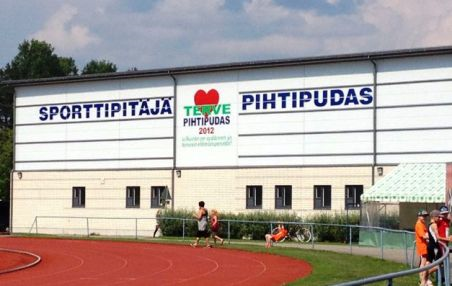 The prep athletes just returned a few weeks ago from the project’s section excursion to Finland. In both 2012 and 2013, athletes enjoyed several days at the IAAF-certified national training center in Kourtane, and during that first year also enjoyed a meet in Oulu (4 hours away) against a Finnish junior team. But this time the trip was enhanced by the stupendous opportunity to participate in Javelin Carnival Pihtipudas (pictured at left). “It’s almost like a national holiday in Finland,” said Spier of an event attended by more than 4,000 – all to watch all ages in a single event. After the finals of the carnival, he would write in his daily blog from the trip, “I’ve been at this a long time and never quite experienced anything like what I was part of today.”
The prep athletes just returned a few weeks ago from the project’s section excursion to Finland. In both 2012 and 2013, athletes enjoyed several days at the IAAF-certified national training center in Kourtane, and during that first year also enjoyed a meet in Oulu (4 hours away) against a Finnish junior team. But this time the trip was enhanced by the stupendous opportunity to participate in Javelin Carnival Pihtipudas (pictured at left). “It’s almost like a national holiday in Finland,” said Spier of an event attended by more than 4,000 – all to watch all ages in a single event. After the finals of the carnival, he would write in his daily blog from the trip, “I’ve been at this a long time and never quite experienced anything like what I was part of today.”
Leading the coaching for athletes in Finland is Kimmo Kinnunen, the 1991 IAAF World Champion in the jav. Finnish national jav coach (17 years) Kari Ihalainen has also trained the athletes, including coaching with Gorski in North Carolina as well. Ditto for Barry Krammes, a still-active two-time Olympic Trials qualifier. Also helping on the home front is the aforementioned Bill Schmidt. It truly has been a coaching staff with the best from two nations.
To date, the Foundation has invested just under $133,000 on the Project: $25,350 in 2011 (no Finland trip), $52,625 in 2012 (includes trip for six to Finland), and $55,000 this year (includes trip for eight to Finland).
Gorski said “you can’t put a price” on how valuable the experience is of traveling to Finland, training there, and a competing in a meet like the Carnival. “Words can’t describe how positive it is. It’s such a benefit to go where the event is revered like it is in Finland, for them to experience that, as well as the cultural aspects of the trip ... the openness of the Finnish people and their willingness to share what they have. They’re so welcoming.
“When they’re back home and out training the kids can think back to what it was like in Finland. It will keep the them motivated.”
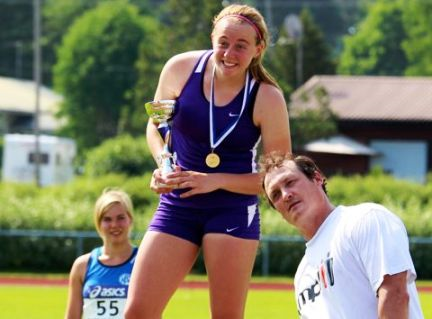 “I’m really excited,” Gorski added, reflecting on the accomplishments of Year Three of the Project. “The main thrust is long-term ... we hope to see these kids competitive at the NCAA level and challenging for Team USA berths in the Olympic Games and World Championships. But look at what the kids did at the Javelin Carnival, with Katelyn winning the MVP, and Megan and Todd throwing personal bests. They’re achieving short term goals, too.”
“I’m really excited,” Gorski added, reflecting on the accomplishments of Year Three of the Project. “The main thrust is long-term ... we hope to see these kids competitive at the NCAA level and challenging for Team USA berths in the Olympic Games and World Championships. But look at what the kids did at the Javelin Carnival, with Katelyn winning the MVP, and Megan and Todd throwing personal bests. They’re achieving short term goals, too.”
Gorski was speaking of Katelyn Gochenour, the aforementioned Megan Glasmann, and Todd Ogden – who certainly epitomize both the short term success and long term aspirations of the Project. Gochenour, who just completed her freshman year at Marian Catholic in Omaha, Nebraska, earned the terrific bounty of the Javelin Carnival Pihtipudas’ Most Valuable Performer (pictured at right) for her victories in both the 15-and-Under and 17-and-Under divisions. Shortly after arriving home from Finland, Gochenour threw a PR 156-8 in a USATF region meet, good for US#6 and the top freshman mark in the country.
Todd Ogden (pictured below left), a rising senior at Glacier HS in Kalispell, Montana, was a 199-footer as a soph in 2012, then had improved through the Project to 210-8 during the regular season. At the Carnival, he reached a PR US#4 211-11. “It’s great to see the javelin appreciated like it is here,” he said. Talking about what he’s learned through a year in the Project, he added, “I’ve really learned how to train differently, to mix it up and not just go out and throw five days a week. I’ve learned I need to run and build some endurance. Technically, for example, I’ve learned about focusing on using my hip flexor more.”
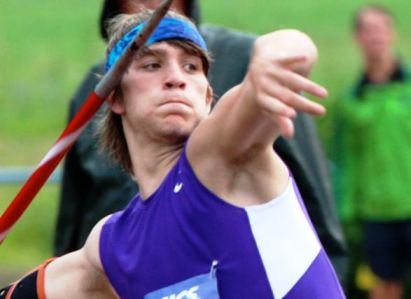 As for Megan Glasmann (pictured below right), headed to Stanford after completing her senior year at Park City, a stupendous US#2 168-1 PR was the latest and greatest of a season full of accomplishments. A 149-footer as a junior, she reached 159-1 to win New Balance Nationals Outdoor, then 166-7 to take USA Juniors and qualify for the Pan Am Junior team. She’s also added a USATF JO title.
As for Megan Glasmann (pictured below right), headed to Stanford after completing her senior year at Park City, a stupendous US#2 168-1 PR was the latest and greatest of a season full of accomplishments. A 149-footer as a junior, she reached 159-1 to win New Balance Nationals Outdoor, then 166-7 to take USA Juniors and qualify for the Pan Am Junior team. She’s also added a USATF JO title.
“This trip was absolutely spectacular,” she told Paul Limmer in a video interview while in Finland. “Last year, watching the girls throw, to be completely honest, I was jealous!”
Glasmann had attended the October 2011 clinic in Chapel Hill (but missed the December clinic due to a concussion) and recalled working towards a goal of being able to earn an invitation for the trip. “As a rising thrower, it was yet another goal to work toward, and seeing up close the type of training and coaching available to the selected team members motivated me to work even harder than I would have otherwise, knowing the unbelievable learning possibilities that would be open to me if I became an elite thrower and was selected.”
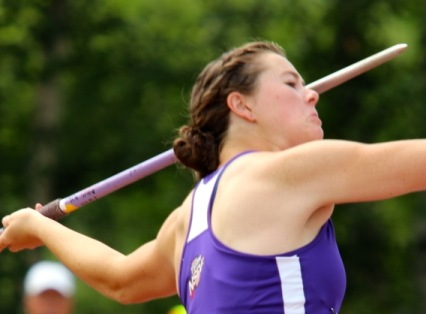 For 2013-14, the selected participants (who will ultimately travel to Finland next summer) so far are Bulger plus the five returnees from this past year: Gochenour, Ogden, Newberg OR rising senior Trevor Danielson, Mead WA soph Josh Ritchter, and Ruston LA junior Karen Clark. Two more are to be selected.
For 2013-14, the selected participants (who will ultimately travel to Finland next summer) so far are Bulger plus the five returnees from this past year: Gochenour, Ogden, Newberg OR rising senior Trevor Danielson, Mead WA soph Josh Ritchter, and Ruston LA junior Karen Clark. Two more are to be selected.
As Gorski and Schmidt look toward growing the Project and improving javelin results for U.S. athletes in general, there’s a few things they agree are keys to developing more outstanding preps and internationally competitive athletes at the top.
Both would like to see more clinic opportunities spread around the country. “I’d like to see the clinics become a road show,” said Gorski, “to get our guys to travel to different areas and expose more athletes to this.”
“Why not have a javelin carnival here?” said Schmidt. “And I would like to see regional clinics, as well.”
There are those who might point to the fact that there are only 17 states where the javelin is contested at the high school level, but Gorski doesn’t see that as an impediment. “There are kids who throw it in every state in the Junior Olympics. There are plenty of numbers.”
Another big thing is this: Developing more coaches who can competently teach the event. “The coaches have got to get motivated,” said Gorski, citing numbers that indicate that out of 300 clinic participants the past year, less than 20 were coaches. “There’s a woeful lack of knowledgeable coaches in this event. That’s the biggest bugaboo. Most track coaches are former distance runners and come from that background.” He added that it doesn’t really take a lot of hours of focused training for a coach to become significantly more competent in the javelin and other throws.
Another issue helping to ensure that qualified athletes in the event are afforded the same opportunities as their peers in other events. Why the top girls javelin finishers at the Youth Trials didn’t get chosen for Team USA is “beyond my comprehension,” said Gorski. He also pointed out a situation in a previous World Trials, in 2009, when athletes were compelled to use inferior javelins provided by the USATF while attempting to qualify. Gorski now provides javelins himself for that competition. Arionne Allen, the Associate Director of Youth Programs for USATF, has been invited to this fall’s first camp in October.
Schmidt would like to see cooperation at all levels, including the collegiate coaches association and the USATF, with the goal of building prospects in the javelin. “It has to be results-driven, focused on how we get better. We’ve got to help each other to get there.”
In addition to Project Kultan Keihas, another NSAF event that is benefitting javelinists and all throwers is the Chicagoland Throwers Series, a handful of competitions scheduled at Illinois Benedictine that began June 7. Schmidt is spearheading that program.
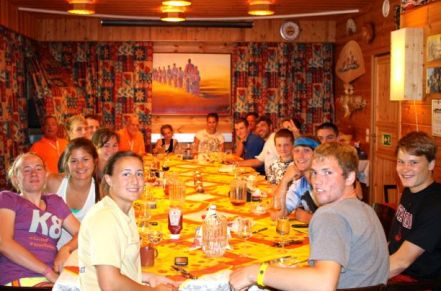 “The NSAF has done a phenomenal job with this and afforded me an opportunity from a funding standpoint,” he said. The unique aspect of the events, in particular the first one, was structuring a competition where prep athletes throwing their own implements could compete alongside Olympic team contenders and other active post-collegians.
“The NSAF has done a phenomenal job with this and afforded me an opportunity from a funding standpoint,” he said. The unique aspect of the events, in particular the first one, was structuring a competition where prep athletes throwing their own implements could compete alongside Olympic team contenders and other active post-collegians.
“When these kids get to see and compete alongside people better than themselves, they realize it can happen for them, too,” he said.
And, when athletes get a chance to do what Bulger and the rest will do in Project Kultan Keihas in 2013-14, the “it” Schmidt mentioned starts happening for them.
(Photo at left of 2013 Kultan Keihas group enjoying dinner during the Finland trip)
“We are thrilled she is getting this opportunity to really work on her javelin skills,” said Brenda Bulger, Karen’s mother. “I think it will be instrumental in how far she can throw in the 2014 season, doing the off season clinics to pick up tips and be critiqued by top experts.
“I think it’s wonderful that NSAF recognizes the need for the United States to develop and train young javelin throwers who have the potential to compete at the international level ... The fun part will to be at these clinics with other top guy and gal throwers, they all have that in common, to strive to be their best with the help of the expert coaches Jeff Gorski and Kimmo Kinnunen.
“Karen is going into her senior year and has had quite a lot of interest from colleges across the country, and to add Project Kultan Keihas to her resume is outstanding. We have been telling friends and family what a great opportunity the National Scholastic Athletics Foundation is giving these elite youth athletes.”
The NSAF will be selecting one female and one male individual to be part of the 2013-14 Project Kultan Keihas elite athlete team. It is open to those who are sophomores, freshman or 8th graders in the Fall of 2013 (this fall). Selected athletes will receive their travel, accommodations and related clinic expenses covered for two Kultan Keihas Javelin clinics, October 17-20, 2013 and December 27-30, 2013 in Chapel Hill, NC, and for the Kultan Keihas Javelin Immersion Experience trip to Finland in the summer of 2014 to the Javelin Carnival in Pihtipudas and to Finland's Olympic Training Center in Kuortane. The application deadline is September 1, 2013.
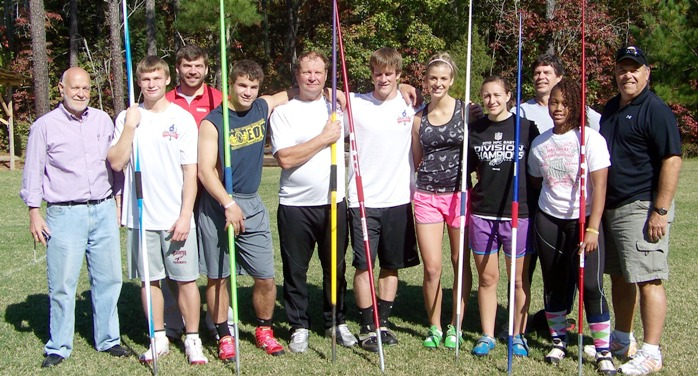
The original 2011 Kultan Keihas crew at Jeff Gorski's javelin facility in Chapel Hill that October.

